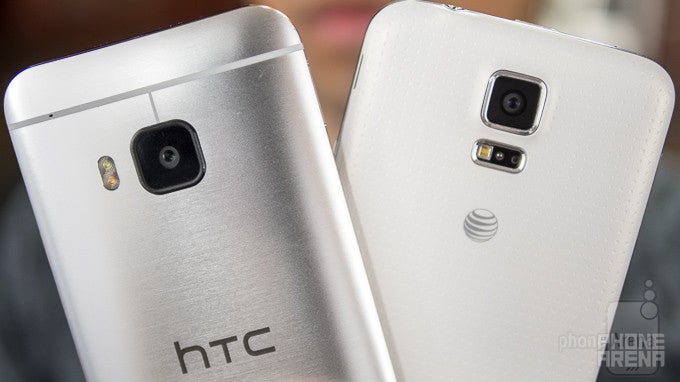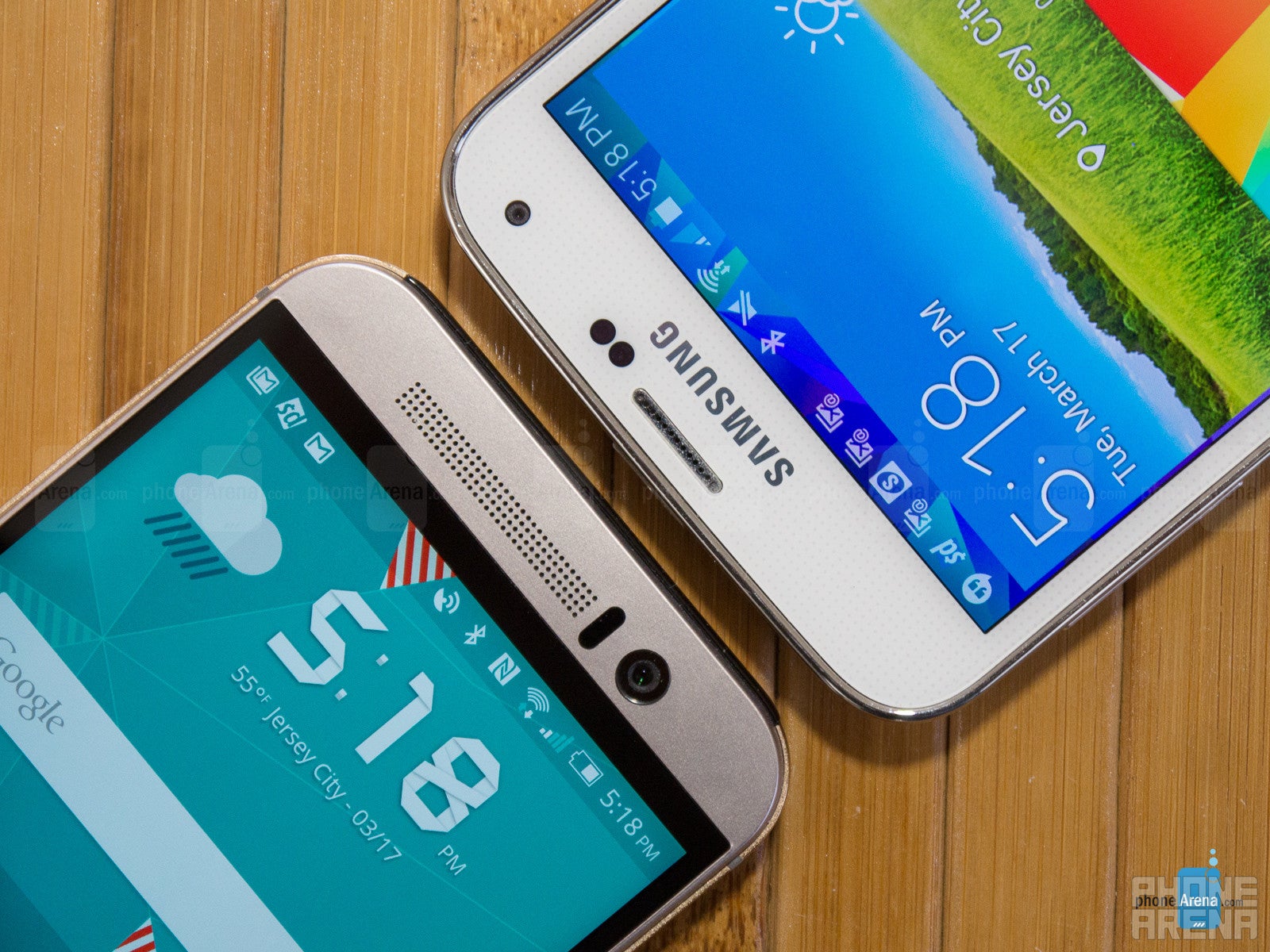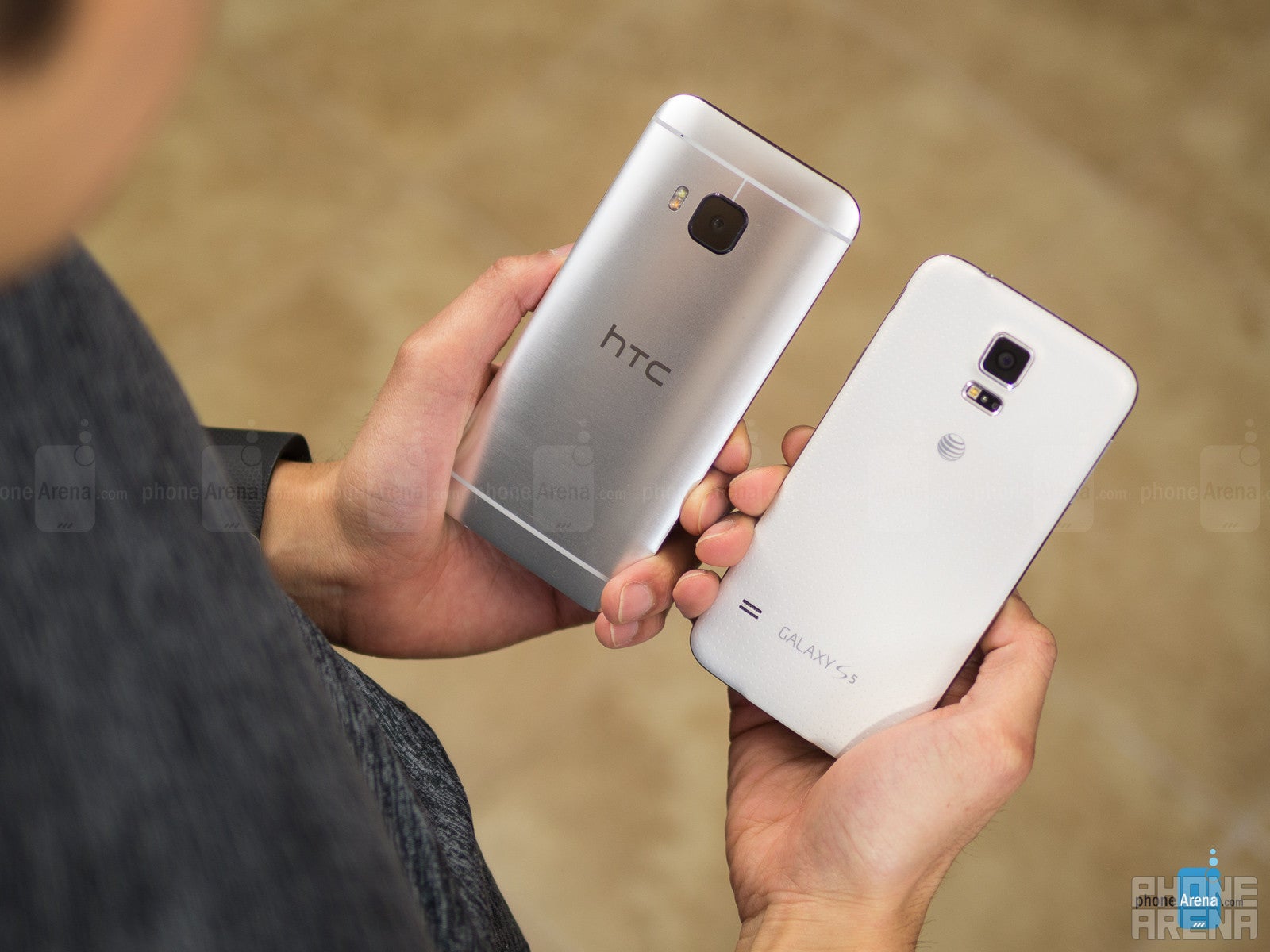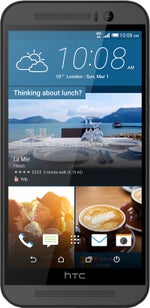HTC One M9 vs Samsung Galaxy S5

Introduction
HTC just outed the next heir to its flagship lineup. The One M9 largely keeps the premium metal unibody aura of its predecessor, but upgrades the internals with a faster Snapdragon 810 chipset, and a high-res 20 MP camera.
Will those be enough to warrant the price difference with Samsung's 2014 darling? The Galaxy S5 is still a viable alternative to the M9 with a 1080p screen and a high-res camera of its own, but a less premium build, so let's clash those two, and find out...
Design
The stylish, all-metal HTC One M9 looks all the more impressive when next to the plastic Galaxy S5, and it flaunts stereo speakers, too.
The One M9 has one distinctly visible advantage before the S5 in terms of design, which is its premium two-tone metal unibody, to which the Galaxy S5 can bounce a largely plastic one, with a tacky faux leather back cover. HTC's offering also proves to be more pleasant in terms of overall aesthetics, compared to Samsung's largely generic design language.
Still, the Galaxy S5 turns out to be somewhat more flexible, as it offers a removable battery cover, which lets you swap the battery quickly, plus it sports an IP67 waterproof rating, allowing you to submerge it in up to three feet of water for half an hour. Meanwhile, the One M9 claims IPx3 only, meaning you can just use it in light rain, for instance.
HTC, however, adorned the M9 with two BoomSound stereo speakers at the front, each of them with a dedicated amplifier. Samsung's bet on differentiation are biometrics, such as a fingerprint scanner embedded in the home key, and a heart rate sensor on the back, which work as advertised, though we prefer Apple's or Huawei's touch approaches to fingerprint recognition.
HTC's phone has on-screen navigational keys, but because of the two BoomSound front speakers, and a largely space-wasting strip with the logo there, it ends up with a tad smaller screen-to-body ratio than the S5. Galaxy S5 has a very similar (read: bad) screen-to-body ratio, but it has a largish physical home key at the front to show for it. The One M9 is narrower than the S5, but since it's thicker, too, and rather slippery in your palm, one-handed operation is not easier than on Samsung's phone. When it comes to physical buttons, they are conveniently placed around both phones, and with good tactile feedback.
Looking at the back, we find the 16 MP camera of Samsung's flagship placed smack in the upper middle, and so is the 20 MP snapper of the M9, so your fingers won't get in the way while shooting in landscape mode with both handsets.
Displays
Despite the difference in screen technologies, both phones manage to suffer from inaccurate color presentation.
The phones have almost the same screen diagonals – 5” for the One M9, and 5.1” for the S5, and the same 1080 x 1920 pixels resolutions, so both sport excellent 400+ ppi pixel densities. Surprisingly, despite the totally different screen technologies – LCD for the M9, and AMOLED for the Galaxy S5 – the companies managed to pull off inaccurate color representation on both.
While cold, off-base and oversaturated colors were to be expected from Samsung's AMOLED screens, at least until the Note 4, we measured something similar with the M9, too. Its panel returned 8100 Kelvins, which is definitely on the colder side of the spectrum, compared to the 6500K white point reference, and makes the screen appear blusih. The hue presentation is all over the place when it comes to the reds and their derivatives, too, as you can see in the color charts below.
Thankfully, the One M9's screen is fairly bright, at a 508 nits peak, which would help outdoor viewing. The Galaxy S5's screen, however, can also be very luminant in auto brightness mode, and is with low screen reflectance, so the outdoor visibility of the two ranks well. When it comes to the minimum brightness, though, the S5 excels with its meager 2 nits, against the eyeball-busting 10 nits you will get from the M9 when trying to read something at night. The phones also offer a super-sensitive touch layer that can be turned on and off at will, allowing you to operate the screen with gloves when needed.
Interface
The cluttered TouchWiz is a bit more function-laden than Sense 7, but HTC offers more useful extras presented in a consistent manner.
Carrying the latest Android 5.0 Lollipop, the One M9 and Galaxy S5 sport very different interface overlays. Both HTC Sense 7 and Samsung TouchWiz are very far from the stock experience in terms of visuals, offer numerous theming options, and carry plenty of extra functions.
Samsung throws most every functionality imaginable in its TouchWiz interface, making it appear a tad overbearing. The S5 has a Pop-up View mode, for instance, that lets you hover multiple windowed apps on top of the interface, and adds the famed Multi-Window regime. This one allows you to divide the screen in two resizable parts, and run completely separate apps in each. We also get a useful one-handed mode on Samsung's handset, that can shrink the whole interface left or right, as if you are using a handset with a much smaller screen.
The new Sense 7 overlay with its BlinkFeed news aggregator looks a bit cleaner and more polished than its predecessor, and has gained extra functionality, too. The new HTC Sense Home experience, for instance, dons a smart widget that can automagically rearrange apps depending on location, time of day, and the respective usage scenarios. Your office homescreen will be different from the one at home, and so on. This customized UI flow extends to the lock screen, too, which can now show suggestions where to eat when your typical lunch break nears, for instance. If a friend of yours from the social networks has written a review of the places around, you will get that on the lock screen, too; pretty cool.
Processor and memory
The One M9 is a performance beast, though you certainly won't feel underpowered with the Galaxy S5, too.
HTC One M9 is powered by the newest octa-core 64-bit Snapdragon 810, clocked at 2 GHz, with four Cortex-A57 and four Cortex-A53 cores arranged in a big.LITTLE architecture that kicks in the powerful and power-sapping A57s only when needed.
Galaxy S5 runs on a chipset that is two generations prior - Snapdragon 801, clocked at 2.5 GHz, which still runs the interface and apps without much issues. There are some gaps in transitions and redrawing while flicking the interface around, but nothing major. In contrast, the One M9's Sense UI runs like a charm, as it is lighter on resources, and the chipset powering it is way more powerful, as you can see from our benchmark comparison.
Samsung has placed 2 GB of RAM in the Galaxy S5, while the One M9 takes no prisoners, and is outfitted with 3 GB of DDR4 RAM, so you can rest assured you can load numerous apps in the memory, and pick up right where you left off without a hitch. The One M9 comes with 32 GB of storage out of the box, while the S5 has 16 GB of internal memory, but they both possess microSD slots, so you can add more storage at your convenience.
Internet and connectivity
Samsung has equipped the Galaxy S5 with two browsers – its own TouchWiz piece, and Google's Chrome, while the One M9 ships with Chrome only. The browsers on both handsets perform admirably while scrolling, panning around, or zooming, but we would give our preference to the TouchWiz renderer – it's not with the prettiest of interfaces, but is faster, and lets you sideload Adobe Flash.
The phones flaunt 4G LTE connectivity, with market-dependent bands support, and 42 Mbps HSPA+ modems.We also get Wi-Fi/ac, Wi-Fi Direct, Bluetooth 4.0, A-GPS, DLNA, and NFC on the phones. They also sport an infrared sensor for controlling your home electronics to the mix. Both handsets offer MHL ports for wired connectivity, letting you hook them directly, or through an adapter, to a TV.
Cameras
Abysmal night shot algorithms of the One M9 ruin the otherwise decent impressions from its camera, compared with the S5.
HTC's flagship comes with a 20 MP camera and dual LED flash, while the S5 has a 16 MP module with single flash only. Both offer f2.2 aperture, but the One M9 has a 28mm focal length equivalent, which casts a wider frame net than the 31mm equivalent of the S5. As for the frontal cameras, while the S5 comes with your run-of-the-mill 2 MP shooter, HTC placed its notorious 4 MP UltraPixel sensor there, albeit without the autofocus mechanism. Speaking of autofocus, the phones are very fast, with Samsung's Phase Detection tech giving it a slight edge. When it comes to actually recording the snap to memory, the HTC is a tad faster, though, so overall it evens out, and shot-to-shot times are about a second or two, depending on the quantity of light around.
The two camera interfaces are anything but bland, as they sport a bewildering variety of shooting modes, color effects, and neat depth-of-field tricks. You can bet that there are all the basics, such as HDR, Panorama, and so on. Samsung's interface is a tad more cluttered, but if you are shooting in the default automatic modes, taking pictures with both phones is a breeze.
Both phones produce high-quality photos in good lighting, but not exactly identical. There are differences in the color representation, for example – with the One M9 the colors have received a boost in terms of saturation, while the S5 keeps the hues more toned-down. Detail is plenty with both handsets, with a slight advantage for the Samsung phone here, and there are no glaring white balance or exposure issues. Moving on to the front-facing cameras, HTC has the upper hand with a quality 4 MP shooter with the light-gathering UltraPixel tech, which runs quality circles around the S5's just average 2 MP camera.
At night, the One M9 shows abysmally bad results, producing noisy, soft and blurry photos that are more akin to a low-level front camera than a flagship shooter. The Galaxy S5 is not much better, but its night shots are still a level above the M9. One reason might be that HTC made automatic HDR a thing now on the One M9, but forgot to actually attach quality processing algorithms with it, so night shots are usually a rather smudgy collage of a few exposure scenarios. Indoors, though, where the auto HDR rarely kicks in, the One M9 performs pretty well, with sharp, well-defined photos that have no exposure or noise issues, and is a level better than the S5. The One M9's LED flash duo is also a tad more powerful, while still managing to return photos with balanced colors.
Both handsets can record 4K video at 30fps, as well as 1080p footage, plus HD slow-motion footage at 120fps. The videos come out detailed enough, but the One M9 churns out darker footage with a bit blander color presentation, and slower focus adjustment while panning around.
Multimedia
The phones are multimedia powerhouses, supporting every major video format from the box, but we'd have to give it to the One M9 when it comes to music playback.
Both galleries offer grid thumbnail views, and allow for rich picture editing from within the apps, as well as sport plenty of sharing options. Video playback is excellent on both handset, too, as they support DivX/Xvid/MKV files out of the box, and the players offer plenty of extras.
When it comes to the music players, we'd have to give one up to the HTC phone, as it has a much sleeker and more comfortable interface. Both the Sense 7, and Samsung's TouchWiz one have plenty of equalizer and visualization options built in, but the graphical environment on the One M9 looks much more stylish than the squarish Samsung UI. The One M9 also has two BoomSound stereo speakers at the front, which sound marvelous, and this time come with Dolby surround sound technology, too, though this one is somewhat gimmicky on a mobile handset speakers, amplified or not. Galaxy S5 only offers one speaker at the back, which is strong enough, but with a subpar quality.
Call quality
The One M9 offers stellar call quality on both ends, while the S5 gives way in terms of voice clarity in the eapriece.

The Galaxy S5's earpiece is strong enough, but leaves something to be desired in terms of depth and clarity of the voice timbres passing through. Both the One M9, and the Galaxy S5's noise-canceling microphones do a very good job at separating ambient noises, and relaying are voice loud and clear to the other end.
Battery
HTC dropped the ball with battery life on the M9, as it eked out much shorter endurance on our test than the Galaxy S5.

Conclusion
The HTC One M9 is a beautifully crafted handset, next to which Samsung's Galaxy S5 looks quite average, not to mention the aesthetic appeal of Sense 7 over the TouchWiz interface. On paper the HTC beast has every reason to feel superior, too, with a much faster chipset, stereo speakers, and higher camera resolutions. In reality, however, the situation is more nuanced.
While the One M9 undoubtedly feels more premium in the hand, it is slippery, with unimpressive screen-to-body ratio, and has neither the waterproof certification of the S5, nor its swappable battery compartment. Diving further into the details, about the only significant, tangible advantages of the One M9 over the S5 are the better front-facing camera, the audio/call quality, and of course, the newer, red hot chipset.
If you are a design connoisseur and want to stay on the bleeding edge of tech, by any means pick the new HTC flagship. If you can live with a more orthodox-looking chassis, but largely similar abilities, save yourself some of the One M9 price, and get last year's Samsung finest.
Follow us on Google News




















![A new Android bug is making it impossible to install new apps. Are you affected? [UPDATE]](https://m-cdn.phonearena.com/images/article/176703-wide-two_350/A-new-Android-bug-is-making-it-impossible-to-install-new-apps.-Are-you-affected-UPDATE.webp)

Things that are NOT allowed:
To help keep our community safe and free from spam, we apply temporary limits to newly created accounts: